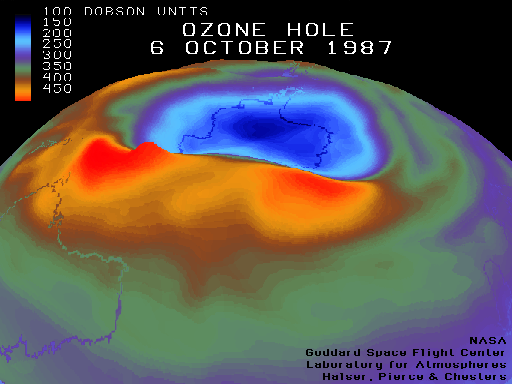
![]() Objectives
Objectives ![]()
Class images
| Phasing Out CFCs: The Vienna Convention and Its Montreal Protocol. (From UNEP.) | |
| Houghton, J. T., G. J. Jenkins, and J. J. Ephraums, 1990: Climate Change, The IPCC Scientific Assessment. Cambridge University Press. p. 27-28. |
2/2/98We continued our discussion of unit 1-9: Ozone reactions. The vital element of this discussion was the idea that CFC´s present a double danger to the global environment: they have the potential for ozone depletion AND they contribute to global warming. More definitively, CFC´s limit ozone production and therefore allow more UV radiation through the atmosphere. But also, CFC´s have high absorbing capabilities at wavelengths between 7 and 10 micrometers-- a wavelength parameter at which the earth radiates with considerable energy. To illustrate this point we viewed a slide from 1-12: Global Energy Balance, which shows the absorption spectra of different substances, including CFC´s, water vapor, carbon dioxide, etc.
We then looked in to the advantages of adding hydrogen to the CFC molecule (HCFC). HCFC´s are more reactive than CFC´s, and therefore are used in the troposphere rather than rising unreacted to the stratosphere.
We briefly touched on the issue of methyl bromide and the controversy surrounding its use and the effort to ban it. Along with this we discussed the idea of a North/South axis where the industrial nations of the northern hemisphere want to regulate methyl bromide, yet less industrialized nations of the southern hemisphere, which rely on methyl bromide agriculturally, have no other other economically viable options. And the northern nations won´t cut them a break, essentially. It´s interesting to note that the U.S. is the chief PRODUCER of methyl bromide in the world.
We then looked at data and figures from Kern and McElroy from their studies in Toronto. Their findings offer convincing evidence that the increased UV radiation is occurring where ozone would ordinarily absorb it.
To close the discussion, we tried to end on a positive note. We examined the projections of the Montreal Protocol of 1987 and it´s revisions of ´90 and ´92 and saw what dramatic improvement can be made to re-close the ozone hole if the nations of the world would adopt the provisions of the Montreal Protocol.
|
Costs and Benefits of the
Montreal Protocol | |
|
CIESIN Thematic Guides: Environmental Effects of Ozone Depletion. | |
|
Ozone Depletion. (Global warming and ozone depletion are different but related issues).
| |
|
Ozone, What Is It, and Why Do We Care About It? | |
|
UNEP's OzonAction Programme: Creating Enabling Conditions | |
| Gleason, J.F., et al., 1993: Record Low Global Ozone in
1992. Science, 260, 523-526. | |
| Hoffmann, D. J., et al., 1992: Observation and Possible Causes
of New Ozone Depletion in Antarctica in 1991. Nature 359, 283-
287. | |
| Houghton, J.T., G.J. Jenkins, J.J. Ephraums, eds, 1990: 1990
Intergovernment Panel on Climate Change, Cambridge University Press,
27-30. | |
| Kerr, R. A., and C. T. McElroy, 1993: Evidence of Large Upward
Trends of Ultraviolet-B Radiation Linked to Ozone Depletion. Science, 262,
1032-1034. | |
| Kerr, R. A., 1993: Ozone Takes a Nose Dive After the Eruption of
Mt. Pinatubo. Science, 260, 490-491. | |
| Lloyd, Steven A., 1993: Stratospheric Ozone Depletion. The
Lancet, 342, 1156-1158. | |
| Rowland, F. Sherwood. 1990: Stratospheric Ozone Depletion by
Chlorofluorocarbons. Ambio, 19, 281-292. | |
| Tabazadeh, A. and R. P. Turco, 1993: Stratospheric Chlorine
Injection by Volcanic Eruptions: HCL Scavenging and Implications for
Ozone. Science, 260, 1082-1085. | |
| Taubes, Gary, 1993: The Ozone Backlash. Science,
260, 1580-1583. | |
| Zurer, Pamela S., 1993: Ozone Depletions Recurring Surprises
Challenge Atmospheric Scientists. C & EN, May 24, 8-18. |